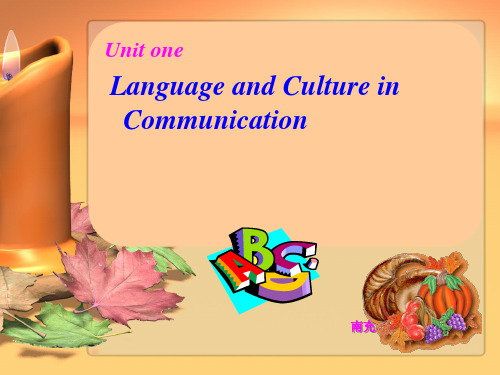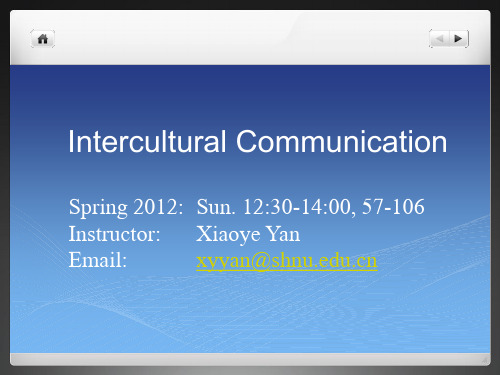高中英语跨文化交际课件Unit 1
unit 1跨文化交际课件

1
Chapter 1
Thinking globally
1
1
Chapter 1: Thinking globally
• 1. what is global village? • With the development of science and technology, the world seems to be getting smaller. The planet Earth is not shrinking, but time and space are. The whole world is like a village with residents from all over the world communicating face to face much more easily.
1
1
Chapter 1: Thinking globally
• 5. How to resolve conflicts over worldviews?
• According to Anderson, there are basically two choices. • 1) the first is to take all worldview stories lightly. Be ready to change them or get rid of them when they are not working. • 2) the second choice is to deny the truths the other stories express, to argue for one story and against a competing one, or in some cases, to prevent the telling of other stories or living by other stories.
Unit 1 Intercultural Communication PPT课件

• Presence: Presence in class is a must. Role-calling will be done
from time to time. 1/3 of absence means
automatically failure
in this course.
• Practice: Practice communicating with English-speaking people whenever the chance comes and write down your experience of
Intercultural Communication: Theory and
Practice
跨文化交际教程
北京大学出版社
Intercultural Communication: Requirements of this course
• Previewing: Preview the text before coming to class.
1. Cross-Cultural Awareness
• What is cross-cultural awareness? • Cross-cultural awareness is the ability to
understand cultures—your own and others’—by means of objective, non-judgmental comparisons. It is an appreciation for, an understanding of, cultural pluralism—the ability to get rid of our ethnocentric tendencies and to accept another culture on its own terms. Many cross-cultural interactions go sour due to a lack of such an awareness.
跨文化交际1PPT课件

2021/7/23
2
-- To familiarize you with basic concepts of intercultural communication. The textbook introduces many of the basic concepts of intercultural communication, assuming that the more students understand about the various factors that affect intercultural communication, the more aware they will be of the role these factors play in influencing how they interpret the behavior of foreigners.
--To help you learn more about the cultures of Western nations. The textbook pays special attention to the culture of the United States, not only because it is the largest English-speaking country, but also because its culture is different from China’s in a number of especially interesting ways.
Lecture One and Twoຫໍສະໝຸດ 2021/7/231
--To help you improve your English, especially your ability to discuss and explain ideas, and your ability to talk about culture in English.
跨文化交际课件Unit_I

• 5 Mary was always regarded as the black sheep of the family
2)The types of communication 1.human communication 2.animal communication 3.human-animal communication 4.human-machine communication 5.machine to machine communication
and funerals
南充职业技术学院卿军
6. 清白 7.白眼 8.青天 9.背黑锅 10.黄色书 刊
6.pure/clean/stainless 7.supercilious look 8.blue sky 9.be made a scapegoat/
be unjustly blamed 10.filthy books
Unit one
Language and Culture in Communication
南充职业技术学院卿军
Teaching Contents
By the end of the unit, you should be able to • Distinguish types of communication • Understand the basics of communication • Be aware of different definitions of a social situation. • Be aware of different values in communication.
跨文化交际-unit-1Communication1PPT课件

• 适当的作笔记;
• 关注对方的肢体语言
– 面部表情 – 姿势 – 个人空间 – 语音语调
.
57
What is culture?
• The term “culture” was first used in this way by the pioneer English Anthropologist Edward B. Tylor (1832-1917)in his book,
.
17
紧张程度
演讲紧张的根源
紧张程度
听众数量 根源(1)观众的数量规模
同类演讲次数
根源(2)内容的熟悉程度
.
18
关于成功者
做别人不敢做的事 做别人不愿做的事 做别人做不了的事
成功其实开始于下定决心
并全力以赴
.
19
演讲成功四要素
明确目标 以终为始 知彼知已
组织内容
主题大纲 加味添料 注重细节
.
29
人类大脑记忆的信息
• 听到的_2_0_%__ • 看到的_3_0_%__ • 看到并听到的_5_0_%__ • 做过的_7_0_%__
.
30
注意力和兴趣曲线
.
31
加味添料
❖ 多媒体 ❖ 适当的幽默 ❖ 人性故事 ❖ 针对性的问题 ❖ 比喻/证据/示范
❖ 实验 ❖ 案例 ❖ 游戏 ❖ 实践演练
呈现形式 用图表说话 PPT制作常识
.
预演彩排 开场白与结束
避免事项
20
演讲的目的——以终为始
❖ 人生的意义 ❖ 成功的标准 ❖ 演讲是为听众,而不是为自己 ❖ 听众最关心什么
.
21
听众的要求——已所欲,施与人
跨文化交际Unit 1课件

Verbal Communication
- Names of objects
- Cultural connotations of words
- The way people use languages
Intercultural Communication : An Introduction 3
Nonverbal Communication - gestures and postures
The Challenge of Globalization
Attitudes towards globalization: - both a fact and an opportunity; - the development of a global mind-set
Cultural diversity must be recognized and appreciated
The
A brief history of the study of ICC
1946: Foreign Service Institute was established in the US 1959: The Silent Language by Edward T. Hall, an American anthropologist, was published, marking the emergence of ICC 1966: ICC was regarded as curriculum in the US 1970: ICC was recognized as an independent area of study by the International Communication Association
跨文化交际unit 1 课件

Introduction to the Course▪1. Aim of the course: understand the cultural differences; communicate more effectively with people from other cultures▪2. Importance of the course:▪a. important for improving general cultural awareness▪b. can be applied in the training of business executive and technicians▪c. training of new immigrants and foreign students▪d. important in foreign language teaching and learning▪3. Way of learning: a. lecture; b. discussion;▪ c. research▪4. Assessment: 70% for final examination▪15% for PPT demonstration or research paper(>800 words)▪15% for class participation and attendance (AQs>3 times)▪5. Textbooks▪Language and Culture 刘润清邓炎昌外语教学与研究出版社▪Intercultural Communication 胡超编著外语教学与研究出版社▪《跨文化交际学概论》胡文仲著外语教学与研究出版社▪Intercultural Communication in Business 王维波,车丽娟主编外语教学与研究出版社Case Study 1▪In China:▪Xiao Li(an interpreter): Y ou must be very tired. Y ou’re old…▪Catherine(a n elderly American lady): Oh, I’m NOT old, and I’m NOT tired.▪In the West:▪A: How are you doing now? Would you like to rest?▪B: No, not a bit.Case Study 2▪In China, it is common to turn on the TV when visitors come to your home. Why?▪The intent is to be sure that your visitors are properly entertained.▪This is a case where the opposite is true in the United States.▪If a person or a family is watching the TV when visitors arrive, it is expected that the TV be turned off (or at least the sound turned dow n) immediately so that one’s full attention may be given to the visitors.Suggested topics for presentation▪1. Watch the movie 《刮痧》and list out the cultural conflicts and discuss them.▪2. What are the similarities and differences between Chinese and English table manners?▪3. What are the taboos related to Chinese Spring Festival and English Christmas?4. Find a copy of English menu and explain it to the class.▪5. Role-play a job interview with your partner.▪6. Compare English and Chinese humor.Unit One IC, Culture, Language and CommunicationUnit 1 Intercultural Communication1.1 Definition of intercultural communication▪It refers to the communication between different cultural backgrounds.▪a phenomenon (跨文化交际) –universal, long existed▪a discipline(跨文化交际学)--first started in the United States. 1959, Edward Hall ―The Silend Language‖ immigrants, foreign students and tourist multi-national and transnational companies1.2 Components of intercultural communication▪a. International communication:▪e.g. Japanese Prime Minister〈--〉American president (this is the communication between two nations)▪b. interracial communication: e.g. Afro American 〈--〉White American▪c. inter-ethnic communication e.g. Tibetan〈--〉Han (they are from different ethnic groups)▪d. inter-regional communication: e.g. A northerner 〈--〉A Southerner1.3 Reasons for the increased intercultural communication▪1. Mobile means of transport▪2. Easy and convenient communication channel▪3. Globalization of world economy.▪4. Mass migration.1.4 Three contributors to successful intercultural communication▪(1) the positive feeling we possess at the affective level, inc luding affirmation, self-esteem, comfort, trust, and safety;▪(2) the beliefs we bring into the intercultural encounter at the cognitive level, inc luding expectations, stereotypes, uncertainties, and misunderstanding of rules or procedures;▪(3) the actions or skills we possess at the behavioral level, including verbal and nonverbal communication skills in intercultural settings.Section 2. Culture2.1 The importance of adequate knowledge of culture▪1. it is necessary for the survival and existence of human beings as human beings.▪Evidence: (1) Wild boy of A veyon (2) wolf children of India▪Victor of Aveyron (also The Wild Boy of Aveyron) was a boy who apparently lived his entirechildhood naked and alone in the woods before being found wandering the woods in France in 1797. ▪wolf children, also known as wild children, are children who've grown up with minimal human contact, or even none at all. They may have been raised by animals (often wolves) or somehow survived on their own. In some cases, children are confined and denied normal social interaction with other people.3▪2. It is necessary in learning a foreign language. In a way, learning a foreign language is learning a foreign culture. It is significant to get the acquaintance with cultural differences and understanding target culture▪Examples: cases of misunderstandings between people from different culturesCase Study 3▪Here is a story of Litz, a Finnish and her Chinese husband.▪Here is the conversation:Litz: Dick, how long is your mum going to stay?Dick: I don’t know. I haven’t asked her.Litz: Why not ask her?Dick: What do you mean by asking her?Litz: I mean what I said. Just ask her how long she’s going to stay.▪Can you diagnose the problem in the communication?Case Study 4▪Jonathan: Ann, your English is improving.I’m pleased with your wor k.▪Ann: (Looking down) Oh, no. My Englishis not very good.▪J: Why do you say that, Ann? Y ou’redoing very well in class.▪A: No. I am not a good student.Continued:▪J: Ann, you’re making progress in this class.Y ou should be proud of your English.▪A: No, it’s not true. Y ou are a good teacher, butI am not a good student.▪Now predict Jonathan’s feeling.▪J: (He is surprised by her response and wonders why she thinks her English is so bad. He doesn’t know what to say and wonders if he should stop giving her compliments.)Continued:▪Question 1: Where do they come from?▪Question 2: Why did Jonathan feel like that?▪Question 3: If Ann is an American girl, what would she respond to Jonathan?Another conversation:▪Jonathan: Ann, your English is improving.I’m pleased with your work.▪Ann: (making eye contact) Thank you. I’ve learneda lot in this course.▪J: Y ou’re doing well and I can really see progress.▪A: I enjoy studying English. I do homework everynight.▪J: I can see that. Keep up the good work.▪A: I’ll try. Y ou are a good teacher. Y ou have helpedme a lot.▪Discussion: Did you ever experience misunderstanding in your communication with a foreigner? Or did you read anything about this? Please describe the situation and analyze the reason.2.2. Different interpretations of culture▪a.我没文化,不识字。
英语跨文化交际实用教程Unit-1(可直接使用).ppt

Never kiss parents
Fake goods everywhere
14
精选文档
Attitudes towards Westerners
Kiss and hug anytime and anywhere
Go Dutch
15
精选文档
Attitudes towards Westerners
3) To identify challenges that arise from these differences in intercultural interactions and learn ways to creatively address them.
6
精选文档
4) To acquire knowledge and develop skills that increase intercultural competence.
Young independent
29
精选文档
A farm family
A photo of Ba Jin’s Family
Insensitive to time
Tending to misunderstand
12
精选文档
Attitudes towards the Chinese People
Obey but not Follow
Being doubtful
13
精选文档
Attitudes towards the Chinese People
Catherine (an elderly American lady): Oh, I’m NOT old, and I’m NOT tired.
Cross-Cultural Communication Unit 1-4 跨文化交际(课堂PPT)

15
CHAPTER 1 - Communication and Culture: The Challenge of The Future
Dominant Culture
Co-Cultures
• It's the one in power -
• They are numerous.
control.
• Distinct and unique
• Meanwhile, aging population in more developed countries – Could bring more communication issues between older generations and younger generations (this can be treated as co-culture).
ethnic background, age, sex,
media, monetary systems,
or other factors.
etc.
16
17
• We learn our culture through proverbs
– Offer an important set of instructions
Our goal in this class is to answer some of the following questions: • Why do we often uncomfortable when encountering people who are different from yourself? • Why do people from different cultures behave in ways that seem strange to you? • How do cultural differences influence communication? • Which cultural differences are important and which are inconsequential? • Why is it difficult to understand and appreciate cultural difference?
Cross-CulturalCommunicationUnit1-4跨文化交际.ppt

a) Each individual are unique. b) Stereotyping. c) Objectivity. d) Communication is not a Cure-all.
CHAPTER 1 - Communication and Culture: The Challenge of The Future
• Culture is – Transmitted from generation to generation – Learned – Shared – Based on symbols – Dynamic – An intergrated system
Cross-CulturalCommunicationUnit1-4跨文化 交际
CHAPTER 1
Communication and Culture: The Challenge of The Future
CHAPTER 1 - Communication and Culture: The Challenge of The Future
– increased the probability of survival
– satisfaction for the participants in an ecological niche
– share with those who could communicate with each other and lived in the same tCommunication:
跨文化交际第一章PPT课件

-
12
Intercultural communicative competence
• The ability to communicate effectively with people from different cultural backgrounds.
• Page 3(举例说明)
-
13
Studying international communication
-
7
• International communication
Communication between people from different nations.
• Interethnic communication Communication between members of the same race but different ethnic backgrounds.
• Interracial communication
• Even the young and the old , the female and the male .
-
8
• What does marriage mean to you ?
-
9
Communication
1.Verbal communication
• Communication that takes place between people of different cultural backgrounds.
-
4
-
5
-
6
How do you understand the concept of different cultural
跨文化交际课件第一章介绍Chapter One-An Introduction

• 11. A comparative study on Western painting/architecture and Chinese painting/architecture. 12. A Comparative study on Western clothes and Chinese clothes. 13. A Comparative study on school education in America and China. 14. A comparative study on family education in America and China. 15. A comparative study on freedom concept in America and China. 16. A comparative study on wedding customs among different countries. 17. A comparative study on Western advertising and Chinese advertising. 18. A comparative study on food culture. 19. A comparative study on wine culture. 20. A comparative study on journalism in America and China.
Warm-up Cases
Case 1 Showing Concern
• In the West: A: How are you doing now? Would you like to rest? B: No, not a bit.
Warm-up Cases
跨文化交际课程第一单元(课堂PPT)

敬请光临。 We would like to have you come.
16
《笑林·寒喧》曾有一则笑话,说明汉语中 “称呼语”之复杂:
甲:你家父今年几岁?近来可安然无恙? 乙:我令尊大人今年六十有二,虽是妙龄,
5
The term “multicultural” is more frequently used in two ways. In a societal sense, it indicates the coexistence of people from many different backgrounds and ethnicities, as in “multicultural societies”. In an individual sense, it characterizes persons who belong to various discourse communities, and who therefore have the linguistic resources and social strategies to affiliate and identify with many different cultures and ways of using language.
了。
14
3.敬语和谦词
英语中有自己的表示尊重和礼貌的形式,但没有 汉语那么多的专用敬语和谦词。因此,汉语中的 “请教”、“高见”、“光临”、“久仰”、 “拜读”、“大作”、“贵校”、“敝人”、 “拙见”、“愚见”、“寒舍”、“薄酒”、 “便饭”等等敬语和谦词,很难在英语中找到等 同的表达方式,同样,英语中表示尊重、礼貌的 情态范畴,如:will、would、may、might、can、 could等等,在汉语中也没有等同的表达方式。
Cross-CulturalCommunicationUnit1-4跨文化交际.ppt

CHAPTER 1 - Communication and Culture: The Challenge of The Future
Dominant Culture
Co-Cultures
• It's the one in power -
• They are numerous.
control.
• Distinct and unique
• We learned our culture through mass media
• Culture is transmitted from generation to generation
• Culture is based on symbols
• Culture is subjected to change
• Subjective elements include: values, beliefs, attitudes, orientations, and underlying assumptions prevalent among people in the society.
• Basic functions of Culture: adapt to a particular ecology, and includes the knowledge that people need to have in order to function in their own social environment.
• Culture is integrated
• Culture is adaptive
CHAPTER 1 - Communication and Culture: The Challenge of The Future
跨文化交际课件Unit_1

Discussion
I. Why take Intercultural Communication?
2012-2-16
4
1. Warm-up Case
Please discuss the case in groups and make a comment on it.
A Case: Showing Concern In China: Xiao Li (an interpreter): You must be
The interpreter gave the impression that he thought the elderly lady would collapse any minute if she doesn’t rest immediately.
2012-2-16
6
Comment
In the West, there is a value placed in being young that many people consciously, or subconsciously, are not willing to accept that they are growing old.
charges with modesty. But Heping did not
跨文化交际第一章 PPT

However, the most common ones are racial stereotypes and gender stereotypes. Race, nationality, gender and sexual orientation are the main factors of stereotyping. Stereotyping must be avoided at all costs, as it leads to treating groups as a single entity. Given below are examples of stereotypes that people commonly use.
intentional and unintentional behavior
The second school of thought proposes that the concept of intentionality is too limiting and fails to account for all the circumstances in which messages are conveyed unintentionally. Scholars who support this approach believe communication takes place whenever people attach meaning to behavior, even if the sender of the message does not expect his or her actions to be conveyed.
跨文交际第一章
After this chapter, we will be able
- 1、下载文档前请自行甄别文档内容的完整性,平台不提供额外的编辑、内容补充、找答案等附加服务。
- 2、"仅部分预览"的文档,不可在线预览部分如存在完整性等问题,可反馈申请退款(可完整预览的文档不适用该条件!)。
- 3、如文档侵犯您的权益,请联系客服反馈,我们会尽快为您处理(人工客服工作时间:9:00-18:30)。
Buddhism. Are you a Buddhist? Buddhists are taught to live for kindness rather than evils.
Catherine (an elderly American lady): Oh, I’m NOT old, and I’m NOT tired.
The Chinese way of showing concern is usually expressed by statement.
In the West:
2012-2-16
17
Why take Intercultural Communication?
People are different throughout the world, culturally, religiously, ideologically and racially, actually different in almost every aspect, therefore we are supposed to know about their differences as much as possible, just for a smooth communication among the Homo sapiens, the people in the global village. You will make it by coming to Intercultural Communication.
2012-2-16
19
The Objectives
1) To explore cultural self-awareness, other culture
awareness and the dynamics that arise in interactions between the two. 2) To understand how communication processes differ among cultures. 3) To identify challenges that arise from these differences in intercultural interactions and learn ways to creatively address them. 4) To acquire knowledge and develop skills that increase intercultural competence. 5) To have an understanding of the meaning of the cultures understood by the westerners and the easterners or the Chinese and Americans.
2012-2-16
16
If only 100 people left in the global village
1. 61 Asians 2. 12 Europeans 3. 8 North Americans 4. 5 South Americans 5. 13 Africans 6. 1 Australasian
A: How are you doing now? Would you like to rest?
B: No, not a bit.
The western way of showing concern is mainly displayed with question.
2012-2-16
7
Comment
Business Culture: ready to move farther and farther, making more profits for showing the value of life.
2012-2-16
11
If only 100 people left in the global village
2012-2-16
8
2. Different attitudes towards the same object When one coin was lost…
American man: Called a policeman,
gave him his telephone number,
left with a chewing gum in his
1. 17 speak Chinese 2. 9 speak English 3. 8 speak Dard 4. 6 speak Spanish 5. 6 speak Russian 6. 4 speak Arabic. 7. 50 speak Bengali Bangladesh,
Japanese or French.
Please discuss the case in groups and make a comment on it.
A Case: Showing Concern In China: Xiao Li (an interpreter): You must be
very tired. You’re old… Catherine (an elderly American lady):
Generally, the people in the world are classified into four major races, though not universally accepted.
White/Caucasian; Mongoloid/Asian; Negroid/Black; Australoid/Brown
2012-2-16
6
The western way of showing concern is generally different from the Chinese way.
In China:
Xiao Li (an interpreter): You must be very tired. You’re old…
Westerners are being individualist, being equal and different. It is none of my business.
2012-2-16
15
6. People are racially different
We are Hopo sapiens.
Japanese man: felt sorry for his own carelessness, still blamed him at home, swearing not to make such a silly mistake again.
2012-2-16
10
3.People are culturally different
This case clearly shows that translation is an intercultural communication, which requires the translator/ interpreter to possess both English cultural knowledge and language competence.
2012-2-16
12
4. People are religiously different
Christianity. About 21.4 billion Christians in the world. Bible. For philanthropy and equal for everybody.
Oh, I’m NOT old, and I’m NOT tired.
2012-2-16
4
Comment
What the interpreter said is quite courteous in China. It means, “If you are tired, we can take a little rest, since you are getting on in years.”
Agricultural Culture: worship land, love land, depend upon land, staying at point with moving
Nomadic Culture: worship nature, love nature, depend upon nature, moving from one place to another, not fixed at one point.
2012-2-16
14
5. People are ideologically different
Chinese people and Asians are a bit modest, live for harmony, trying to avoid face to face conflict. Being collectivist.
2012-2-16
13
If only 100 people left in the global village
1. 33 Christians 2. 18 Moslems 3. 14 Hindus 4. 16 no religion 5. 6 Buddhists 6. 13 different religions
Intercultural Communication
A Practical Coursebook
